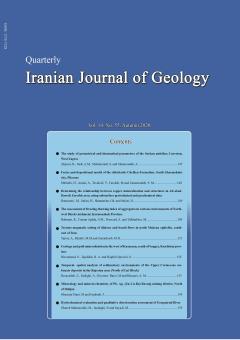The assessment of freezing-thawing index of aggregates in various environments of Northwest Direh catchment, Kermenshah Province
Subject Areas :کاظم بهرامي 1 , Seyed Mahmoud Fatemi Aghda 2 , Ali Noorzad 3 , Mehdi Talkhablou 4
1 -
2 -
3 -
4 -
Keywords: Alluvial fan, Geological environments, Aggregate, Freezing-Thawing,
Abstract :
Considering the effects of geological environments of natural aggregates accumulation on the weight loss rate of aggregates resulted from freezing-thawing, the relationship between geological environments and the weight loss rate of aggregates has been investigated in this study. The lithology of upstream catchment was the same (thick Asmari limestone) for all aggregates samples. Samples were gathered from 2 taluses, 12 fans and 3 river beds. Samples were transferred to laboratory and then the weight loss rate (in accordance with tex-432- A standard) and the jointing intensity were measured. Based on the results, colluvial environments (taluses) have the highest weight loss rate (14% for size of 16-19 mm) and river environments have the lowest weight loss rate (less than 1% for size of 2.36-4.75 mm). The aggregates of alluvial fans have the intermediate amount compared to two previous environments. In alluvial fan aggregates, the weight loss rate decreases when the area and length of main stream of catchments increases. Also, aggregates size affects the weight loss rate so that increase in the size of aggregate causes the rise in weight loss. Relationship between aggregate size and weight loss rate is affected by geological environments. The difference of weight loss between fine and coarse aggregates is high in talus environments as well as alluvial fans with small catchments, while it is less in river beds and fans with large catchments. In fact, the size effect of aggregate on weight loss decreases or eliminated in river beds and fans.
گزارش هوا و اقلیم حوضه آبخیز پشت تنگ. 1379. شرکت خدمات مهندسی جهاد سازندگی استان کرمانشاه.
نقشه زمینشناسی 250000/1 ورقه قصر شیرین. 1973. شرکت ملی نفت ایران.
ACI 201.2R-08., 2008. Guide to durable concrete.
ACI 221R-96., 2001. Guide for use of normal weight and heavy weight aggregates in concrete.
Alexander, M. and Mindess, S., 2005. Aggregate in Concrete. Taylor and Francis, 435.
Bahrami, S., 2013. Tectonic controls on the morphometry of alluvial fans around Daneh¬khoshk anticline, Zagros, Iran. Geomorphology, 180-181, 217-230.
Janssen, D.J. and Snyder, M.B., 1994. Resistance of Concrete to Freezing and Thawing. Report SHRP-C-391. Strategic Highway Research Program, Washington, DC, 201.
Kang, Y.S., Liu, Q.S. and Huang S.B., 2013. A fully coupled thermo-hydro-mechanical model for rock mass under freezing/thawing condition, Cold Regions Science and Technology, 95, 19-26.
Kang, Y.S, Liu, Q.S, Liu, X. and Huang, S.B., 2014. Theoretical and numerical studies of crack initiation and propagation in rock masses under freezing pressure and far-field stress. Journal of Rock Mechanics and Geotechnical Engineering, 6, 466-476.
Karimi, H., Raeisi, E. and Bakalowicz, M., 2005. Characterising the main karst aquifers of the Alvand basin, Northwest of Zagros, Iran, by a hydrogeochemical approach. Hydrogeology Journal, 13, 787–799.
Litvan, G.G., 1973. Pore structure and frost susceptibility of building materials, Research Paper No. 584, Division of Building Research, National Research Council of Canada, Ottawa, 17-30.
Mac Innis, C and Lau, E.C., 1971. Maximum aggregate size effect on frost resistance of concrete, Journal of American Concrete Institute, 68, 16, 144-149.
Matsuoka, N., 1990. Mechanisms of rock breakdown by frost action: an experimental approach. Cold Regions Science and Technology, 17, 253-270.
Mindess, S., Young, J.F. and Darwin, D., 2003. Concrete. New Jersey: Pearson Prentice Hall, 644.
Montoto, M., Rodrı´guez-Rey, A., Mene´ndez, B., Martı´nez-Nistal, A., Ruiz de Argandon˜a, V.G., Sua´rez del Rı´o, L.M. and Calleja L., 1994. Microfractography of El Berrocal granite. In: Maravic, H., Smellie, J. (Eds.). Proceedings of an international workshop Nuclear Science and Technology, 353–358.
Neville, A.M. and Brooks, J.J., 2010. Concrete technology. Prentice Hall. 456.
Park, J., Hyun, C.U. and Park, H.D., 2015. Changes in microstructure and physical properties of rocks caused by artificial freeze–thaw action. Bulletin of Engineering Geology and the Environment, 74, 555–565.
Ruedrich, J. and Kirchner, D., Siegesmund S., 2011. Physical weathering of building stones induced by freeze-thaw action: a laboratory long-term study. Environmental Earth Sciences, 63, 1573–1586.
Schedl, A., Kronenberg A.K. and Tullis J., 1986. Deformation microstructures of Barre granite, an optical SEM and TEM study, Tectonophysics 122, 149– 164.
Seto, M., 2010. Freeze-thaw cycles on rock surfaces below the timberline in a montane zone: field measurements in Kobugahara, Northern Ashio Mountains, Central Japan. Catena, 82(3), 218-26.
Smith, M.R. and Collis, L., 2001. Aggregates: Sand, gravel and crushed rock aggregates for construction purposes (third edition). The Geological Society London. 339.
TEX-432-A., 2014. Test procedure for coarse aggregate freeze-thaw test. Texas Department of Transportation.
Wang, P., Xu, J., Liu, S., Liu, S. and Wang, H., 2016. A prediction model for the dynamic mechanical degradation of sedimentary rock after a long-term freeze-thaw weathering: Considering the strain-rate effect, Cold Regions Science and Technology, 131, 16-23.
Washburn, A.L., 1979. Geocryology: A Survey of Periglacial Processes and Environments. Edward Arnold, London, 406.
Yang, Z.J. and Chen, J.F., 2004. Fully automatic modelling of cohesive discrete crack propagation in concrete beams using local arc-length methods. International Journal of Solids and Structures, 41, 3-4, 801-26.
Yavuz, H., Altindag, R., Sarac, S., Ugur, I. and Sengun, N., 2006. Estimating the index properties of deteriorated carbonate rocks due to freeze-thaw and thermal shock weathering, International Journal of Rock Mechanics and Mining Sciences, 43, 767-775.


